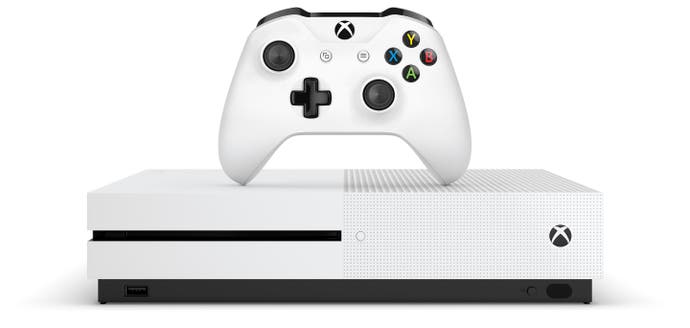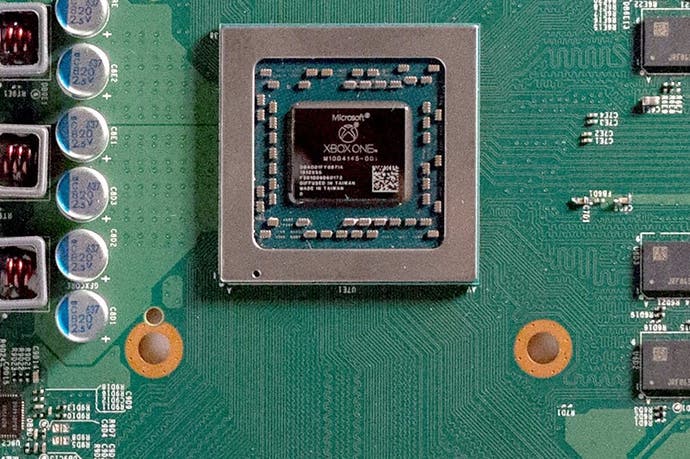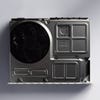Tech Interview: Inside Xbox One S
A Digital Foundry deep dive on the making of Microsoft's latest console.
Microsoft's reveal of the Xbox One S at E3 this year left us with questions. Lots of them. How did the firm graft on 4K support to the existing hardware? Are we looking at a processor shrink and an architectural revamp? What formats of HDR are supported? Can selected titles actually run at a native 4K resolution? Does the support for UHD Blu-ray movies actually require a new and improved BD drive? The list goes on. And on.
And then there's the question of just how much extra power the Xbox One S possesses compared to the original hardware, and what form it actually takes: is it extra clocks or unlocked compute units? It's fair to say that this was something of a confused issue at E3 and we wanted to get to the bottom of the issue.
During the show, I contacted Microsoft's Albert Penello - senior director of product marketing and planning - with a view of getting the complete picture on a product that was clearly much more than just a console refresh. It's a fascinating story and one that I'm happy to share with you today, along with an in-depth analysis of the spec bump and what it means for Xbox One gaming, plus a full review of the Xbox One S hardware and a round-up of everything we know about Xbox One S.
In the meantime, sit back and enjoy this full breakdown of the engineering innovations found in Xbox One S, from discussion on the 16nm FinFET SoC redesign, complete disclosure on just how much more powerful the new console is, plus the exclusive imagery below, taking us beneath the plastic shell all the way down to the Xbox One S's new motherboard and revised processor.
Digital Foundry: Slimmer, smaller consoles are often made possible with process shrinks. Xbox One runs with a 28nm processor - does Xbox One S stick with that, or are you using a FinFET process? If you're on a smaller process, can you give us an idea of how much smaller the die is now?
Albert Penello: Correct! The SoC in the Xbox One S is designed in the 16nm Fin FET process, which results in a die that is 240mm2; 33 per cent smaller and consumes less power than the 28nm SoC in the original Xbox One.
Digital Foundry: If you are at 16nmFinFET for the new SoC, does that confirm you're using TSMC [Taiwan Semiconductor Manufacturing Company - currently producing Nvidia's new Pascal chips] to fabricate the processor as per Xbox One?
Albert Penello: Yes, for the Xbox One S consoles shipping this year the SoC is fabricated at TSMC.
Digital Foundry: Is the 4K functionality integrated into the SoC, or are you using the existing design with additional external silicon? Assuming a processor redesign, can you outline the changes involved? Are you essentially updating the media blocks but leaving everything else as is?
Albert Penello: There are several components required to support the 4K UHD video playback that result in a combination of changes in the new console. First, we added a 4K HEVC decoder to the SoC to render the compressed video streams efficiently in hardware. Next, we updated the video output to HDMI 2.0 and HDCP 2.2. The interface revisions are all integrated into the SoC and enable outputting video at the higher bandwidths required for 4K UHD and HDR formats, as well as the copy protection tech required for protected content. And of course, we updated the optical drive to support the BD-UHD disc format.
Digital Foundry: Can developers address a 4K framebuffer? Obviously we can't expect native 4K triple-A gaming, but simpler titles and 2D games could potentially work well - plus existing Xbox One owners would get 2x super-sampling.
Albert Penello: If they want to, they can. As you said, if a developer had a game that could use it we are enabling 4K framebuffers, but only on Xbox One S consoles.
Digital Foundry: Can you give us the technical details on the scaling algorithm used to take 1080p to 4K?
Albert Penello: We use the same hardware block and algorithms to scale directly from the game's render resolution to 4K as we do with the current Xbox One when scaling to the TV's input resolution.
Digital Foundry: Xbox One shipped with an exceptionally robust cooling solution for the processor. The new console is much smaller - how is it cooled and can we expect similar acoustic performance to the launch unit?
Albert Penello: Reducing the power consumption of the SoC opened up opportunities to reduce the size of the chassis significantly. We've been listening to feedback and we know people value smaller size and the convenience of an internal power supply, so these became critical factors when we were designing the Xbox One S. We applied the lessons we have amassed over the years in thermal and acoustic engineering and so we have a design that is not just more compact, but is reliable and quiet enough to blend into the background, whether you are playing a graphically demanding game or kicking back watching a movie. I think people will be just as happy with the volume level of the Xbox One S as they were with the original Xbox One.
Digital Foundry: Is the cooling solution scaled down to match the reduced heat output of the processor? It still looks like a good cooler - based on the image, it looks like you've retained the copper heat pipes? How large is the fan?
Albert Penello: We designed the console to make sure it had great acoustic performance and reliability for the consumer. The cooling solution uses an aluminum heat sink with two heat pipes and a single 120mm axial fan to draw air through the whole system.
Digital Foundry: Are you in a position to talk about power efficiency advantages with the new unit?
Albert Penello: The new SoC consumes less power than the original Xbox One across all modes, and we've made improvements in both the hardware and software to hit our goals. I can't really give a specific number, however, because power consumption varies based on the game or app that is running.

Digital Foundry: We've lost the Kinect port and it stands to reason that you would have refined the mainboard design. Are there any other efficiency improvements and modifications there? For example, do you still use 16 memory modules?
Albert Penello: The motherboard of the Xbox One S was completely redesigned around the new 16nm FinFET SoC, and to fit in the downsized chassis. The core architecture of the SoC, the configuration and number of memory chips all remain the same to provide consistent performance. The custom south bridge IO chip is the same one used on all previous Xbox One consoles. Removing the dedicated Kinect port allowed us to use a smaller power supply and achieve a very clean layout of the rear panel with no double-stacked connectors required.
Digital Foundry: There was some confusion at E3 about faster hardware in the Xbox One S to enable 4K and HDR. This says to us that you've either tweaked CPU/GPU clocks or unlocked the deactivated compute units on the GPU. What is actually happening there?
Albert Penello: This is a great question. In the hectic environment of E3 it's not always possible to get into the level of detail necessary to give a complete answer. We stated that the SoC is the same as Xbox One while giving developers access to more power for HDR. The key is that we did not want customers to expect any change in game performance for existing titles. This has caused people to ask more detailed questions which I'm glad we have time to get into. The SoC in Xbox One is the same design as the previous processor. Same GPU, same number of CUs, same memory, same CPU.
As we discussed, we did make some refinements for 4K support and to fit in the new chassis. We also used this opportunity to increase the GPU frequency from 853 MHz to 914 MHz. By making this change, developers creating HDR titles do not have to incur any performance hit. We also decided to make the extra six per cent available to all titles. So some games (ones that utilise dynamic resolution and/or unlocked framerates) may see a very minor performance improvement. Our testing internally has shown this to be pretty minor, and is only measurable on certain games, so we didn't want to make it a “selling point” for the new console.
Digital Foundry: In a world where most games use HDR internally anyway before tonemapping, what is the need for extra power?
Albert Penello: The extra performance is needed to render real-time non-HDR versions of the game for GameDVR, streaming and screenshots.

Digital Foundry: Would I be right in assuming the GPU clock boost also increases ESRAM bandwidth? Where does that stand now?
Albert Penello: You would be correct! Our ESRAM bandwidth scales proportionately with the GPU clock speed increase. That means our peak goes from 204 GB/s to 219GB/s.
Digital Foundry: Also, can we confirm that Xbox One S CPU clocks remain at 1.75GHz?
Albert Penello: Yes, CPU clock speed is the same.
Digital Foundry: Gears 4 and Forza Horizon 3 will ship with HDR support. Meanwhile, in the PC space, developers are looking to release HDR patches for existing titles - we played Rise of the Tomb Raider in HDR and it was beautiful. Will Microsoft follow suit with HDR support for older games?
Albert Penello: This is totally up to the developers. Having an HDR TV set myself, I would love to see this happen but it's not something we require.
Digital Foundry: Are you using the wider colour gamut (DCI P3) for HDR-enabled titles?
Albert Penello: Not currently. We are not supporting WCG for games in Xbox One S. We are supporting the wider Bt.2020 color gamut in Xbox One S for media, however.
Digital Foundry: We understand you've opted for HDR 10 support rather than (or in addition to) Dolby Vision. What's the reasoning for this? Was it a factor of what was already built into the AMD media block?
Albert Penello: HDR10 is the standard HDR format for the UHD Blu-ray spec, and our understanding is that the majority of consumer TV sets will support HDR10, with Dolby Vision as an option. Dolby Vision looks to be a great technology and we have discussions with Dolby often.
Digital Foundry: From a software perspective, can you outline what 4K and HDR media support we can expect from Xbox One S on day one and what else may be in the pipeline?
Albert Penello: Beyond what we announced at E3, there is nothing new I can talk about now. But you should expect to see a number of media apps and games announced shortly. In addition, I know some fans have asked for new audio functionality including bitstream support and we're evaluating that as a possible feature in a future update.
Digital Foundry: Is the support of UHD Blu-ray solely a software thing, or does Xbox One S ship with a more modern BD drive?
Albert Penello: Great question. I have seen people online believe that you can do a 'firmware' upgrade to our existing BD drive to support 4K, but that's not true. In addition to DSP firmware updates, the drive in the Xbox One S also includes a new optical pickup to support three-layer UHD Blu-ray format discs. Plus HDMI 2.0 video output with HDCP 2.2 copy protection is also a BD-UHD certification requirement, both of which are included in Xbox One S and weren't implemented on the other Xbox One consoles.
Digital Foundry: A more subtle change has been the move to Bluetooth support for the Xbox One controller. Can you talk us through the decision-making process there? Does this introduce any compatibility issues when old pads are used with the new console and vice versa?
Albert Penello: Personally, I think we have best controller ever made! To be clear, connection to the Xbox One S still uses our high-bandwidth, low-latency Xbox Wireless protocol. We make that Wireless Protocol available on PC with ourXbox Wireless Adapter for Windows. However, we wanted people to be able to use their same controller more easily OFF the console in tablet and laptop situations. By adding Bluetooth support people playing on a Windows 10 tablet or PC can use the controller 'on the go'. I think our Xbox One Wireless Protocol provides the best experience, and now I love the added flexibility we provide by adding Bluetooth.







